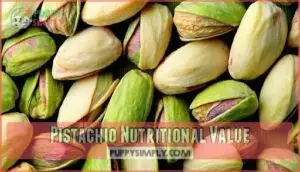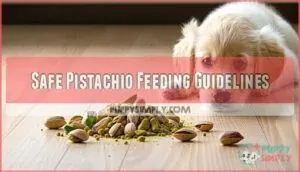This site is supported by our readers. We may earn a commission, at no cost to you, if you purchase through links.

This is a straightforward pet safety question that doesn’t require real-time information or dynamic data, so I can provide a direct answer based on established veterinary knowledge.
You shouldn’t give your dog pistachios, even though they’re not toxic.
These nuts pack too much fat and can cause pancreatitis in dogs.
The shells create serious choking hazards and can block your pup’s intestines, requiring emergency surgery.
Salted pistachios add dangerous sodium levels that stress your dog’s kidneys.
If your furry friend snatches a few plain, shelled pistachios, don’t panic – they’ll likely be fine.
But there are much safer treats that won’t risk your dog’s health or your wallet at the vet’s office.
Table Of Contents
- Key Takeaways
- Dogs Eating Pistachios
- Can Dogs Eat Pistachios
- Pistachio Nutritional Value
- Risks of Pistachio Consumption
- Safe Pistachio Feeding Guidelines
- Pistachio Allergy Symptoms
- Healthy Alternatives to Pistachios
- Pistachio Shell Dangers
- Feeding Pistachios to Dogs Safely
- Pistachio Consumption Precautions
- Frequently Asked Questions (FAQs)
- Can dogs eat pistachio nuts?
- How can pistachios cause choking in dogs?
- Can you eat pistachios on keto?
- Are pistachios bad for dogs?
- What nuts can dogs not eat?
- What happens when my dog eats one piece pistachio?
- Can puppies eat pistachios safely?
- What happens if dogs eat pistachio shells?
- Are roasted pistachios better than raw ones?
- How often can dogs have pistachios?
- Conclusion
Key Takeaways
- Don’t feed your dog pistachios – while not toxic, they’re high in fat and can cause pancreatitis, a serious condition requiring emergency vet care
- Pistachio shells create choking hazards – they can block your dog’s throat or intestines, potentially requiring expensive surgery to remove
- Salted pistachios are dangerous – the high sodium content can cause kidney strain and salt poisoning in dogs
- Choose safer alternatives instead – carrots, apples, or green beans provide healthy treats without the risks that come with nuts
Dogs Eating Pistachios
You’ve probably wondered if your dog can safely munch on pistachios from your snack bowl.
While pistachios aren’t toxic to dogs, they come with several risks that make them a less-than-ideal treat choice.
Nutritional Benefits
Pistachios pack impressive nutrition that benefits your dog’s health.
These nuts deliver high-quality protein (about 21% by weight) supporting muscle development and tissue repair. The healthy fats promote shiny coats and skin health, while fiber aids digestion and gut bacteria growth.
Pistachio vitamins include B6 for nervous system function, plus vitamin E and K. Their mineral content features potassium for heart health, magnesium, iron, and copper.
The antioxidant power from lutein, zeaxanthin, and polyphenols helps combat free radicals. Given their monounsaturated fats, pistachios can contribute to heart health benefits.
When considering pistachios for dogs, their fiber source and nutritional density make them valuable occasional treats for canine dietary needs.
Potential Risks
While pistachios offer nutritional benefits, they come with significant risks for your furry friend.
Aflatoxin exposure from moldy nuts can cause liver damage and potentially fatal poisoning. Urushiol allergy reactions may develop around your dog’s mouth and face, similar to poison ivy effects.
Moldy pistachios and poison ivy compounds make these nuts risky treats for your furry friend.
Sodium poisoning becomes a concern with salted varieties, leading to vomiting and kidney strain. The high fat content creates pancreatitis** risk, a serious condition requiring immediate veterinary care.
Shell obstruction poses choking hazards, while pistachio shell hazard can cause digestive blockages. These toxic nuts dogs should avoid can trigger severe dog digestive issues.
Pistachio poisoning dogs experience varies by size and consumption amount, making this choking hazard particularly dangerous for smaller breeds. Due to the risk of aflatoxins, mold toxicity is possible.
Can Dogs Eat Pistachios
Yes, dogs can eat pistachios, but with significant restrictions. While pistachios aren’t inherently toxic to dogs, they pose several health risks that make them unsuitable as regular treats.
Safe Brands matter when selecting plain, unsalted varieties. Breed Sensitivity varies, with smaller dogs facing higher risks. Proper Shell Disposal prevents accidental ingestion.
One major concern is potential mold toxicity from aflatoxins. This highlights the need for careful selection and handling of pistachios for dogs.
To safely offer pistachios to dogs, follow these guidelines:
- Remove all shells completely before offering any pistachios
- Choose only plain, unsalted pistachios without seasonings or additives
- Crush nuts into small pieces to prevent choking hazards
- Monitor for signs of digestive issues or allergic reactions
- Limit portions based on your dog’s size and weight
Cooking Pistachios doesn’t eliminate risks, and poor Nutrient Absorption can occur with excessive consumption, leading to dog digestive issues. This emphasizes the importance of moderation and careful consideration when including pistachios in a dog’s diet.
Pistachio Nutritional Value
Pistachios pack impressive nutritional value that can benefit your dog when given properly.
These nuts contain high-quality protein for muscle development, healthy fats for energy, fiber for digestion, and antioxidants that support immune function.
Protein Content
When you’re evaluating pistachios for your dog, you’ll find they pack impressive Protein Benefits. Each ounce contains six grams of complete protein with all essential Amino Acids needed for Muscle Growth and repair.
This makes them a solid Energy Source for active dogs when balanced properly. They also offer healthy monounsaturated fats, which can contribute to overall well-being.
| Protein Aspect | Pistachio Facts |
|---|---|
| Protein per ounce | 6 grams (complete protein) |
| Daily value percentage | 10% of recommended intake |
| Amino acid profile | Contains all essential amino acids |
However, Diet Balance remains key—pistachios shouldn’t replace your dog’s regular dog nutrition nuts intake but can supplement it occasionally.
Healthy Fats
You’ll find pistachios pack impressive Fat Benefits that support your dog’s health.
These nuts contain 13 grams of healthy fats per ounce, with most being heart-friendly unsaturated fats that won’t harm your pup’s cardiovascular system.
- Monounsaturated fats make up 54% of pistachio content, supporting heart health
- Polyunsaturated fats provide 31% of total fat, including essential Omega Fatty acids
- Low saturated fat at just 1.5 grams per ounce keeps cholesterol levels healthy
- Cholesterol-free composition makes pistachios safer than many animal-based treats
- Balanced Diet integration possible when following strict Portion Control guidelines
Remember, these Unsaturated Sources offer nutritional value, but moderation remains key for safe snacks dogs can enjoy.
Fiber and Antioxidants
Beyond healthy fats, pistachios pack impressive fiber and antioxidants that support your dog’s digestive health.
Each ounce delivers 3 grams of fiber, promoting gut health and better digestion.
The antioxidant benefits include vitamin E and carotenoids that provide immune support while reducing inflammation.
These compounds help combat free radicals in your dog’s system, however, remember that pistachios should remain occasional treats, not dietary staples for ideal canine nutrition.
Risks of Pistachio Consumption
While pistachios aren’t toxic to dogs, they carry several serious health risks that you should know about.
The high fat content, choking hazards, and potential for allergic reactions make these nuts a risky treat for your furry friend, due to the serious health risks.
Choking Hazards
Pistachio shells pose a serious choking hazard for dogs, especially small dogs with narrower airways.
Shell ingestion can obstruct breathing and cause esophageal injury if fragments splinter. Rapid eating increases choking risk when dogs don’t properly chew nuts.
Whole pistachios can lodge in throats, requiring immediate veterinary attention.
Always remove shells completely before offering pistachios to prevent dangerous choking incidents; it’s important to maintain choking prevention strategies when feeding your dog treats.
Intestinal Blockages
Shell ingestion creates serious digestive dangers for dogs.
When your pup swallows pistachio shells, they can’t break them down properly, leading to dangerous blockages in their intestines.
Obstruction symptoms to watch for:
- Persistent vomiting – especially after eating
- Loss of appetite – refusing favorite foods
- Constipation – straining without results
- Abdominal swelling – visible bloating or tenderness
- Lethargy – unusual tiredness or weakness
Blockage prevention starts with removing all shells before offering pistachios.
If obstruction occurs, veterinary intervention becomes critical.
Surgical removal may be necessary when shells won’t pass naturally through digestion.
Allergic Reactions
Since pistachios contain urushiol (the same compound in poison ivy), they can trigger allergic reactions in sensitive dogs.
Watch for allergy symptoms like hives, facial swelling, vomiting, or difficulty breathing.
Some breeds show greater sensitivity to nut allergies, while aflatoxin effects from moldy nuts can cause severe reactions.
Sodium toxicity from salted varieties adds another risk, as anaphylaxis requires immediate veterinary care, and canine health depends on recognizing these warning signs early.
Safe Pistachio Feeding Guidelines
If you’re planning to share pistachios with your dog, proper preparation is essential for their safety.
Always remove shells completely, crush the nuts into small pieces, and stick to tiny portions based on your dog’s size.
Removing Shells
Always remove pistachio shells before offering them to your dogs.
Shell ingestion risks include choking and digestive issues that can turn a simple treat into an emergency vet visit.
Here’s your shell removal checklist:
- Shell Size Matters – Even small shell fragments can cause problems for dogs of all sizes
- Proper Disposal Methods – Toss shells in a secure trash bin where curious paws can’t reach them
- Supervised Consumption – Watch your dog eat to make certain that preventing shell access works effectively.
To simplify this, consider using a pistachio shell remover.
Crushing or Smashing Nuts
Once you’ve removed the shells, it’s time to break down those pistachios into smaller pieces.
Crushing or smashing nuts prevents choking and helps with digestion improvement by making them easier for your dog to process.
| Method | Tool | Result |
|---|---|---|
| Light crushing | Rolling pin | Smaller chunks |
| Complete smashing | Hammer/mallet | Fine pieces |
| Gentle breaking | Knife handle | Manageable bits |
| Manual crushing | Mortar/pestle | Powder form |
This choking prevention step also increases palatability and enhances nutrient absorption.
A quality rolling pin can assist with this process.
Your dog will find these smaller pieces much easier to chew and digest, making pistachios a safer treat option.
Portion Control
Now it’s time to discuss portion control for your dog’s pistachio treats. Remember, moderation is key in safe feeding practices.
Proper portion control prevents obesity and helps your dog’s diet stay balanced.
Dog size determines how many pistachios you can safely offer:
- Extra-small dogs (2-20 lbs): 1 pistachio maximum
- Small dogs (21-40 lbs): 2-3 pistachios occasionally
- Medium dogs (41-70 lbs): 3-4 pistachios as rare treats
- Large dogs (71+ lbs): 5-6 pistachios infrequently
Calorie counting matters since treats shouldn’t exceed 10% of your dog’s daily intake. Frequency matters too – pistachios should be occasional rewards, not regular snacks, supporting obesity prevention through mindful treat limits.
Pistachio Allergy Symptoms
While pistachios aren’t toxic to most dogs, they can trigger serious allergic reactions that you’ll want to watch for carefully.
These symptoms can range from mild skin irritation to life-threatening poisoning, making it imperative to know what warning signs to look for after your dog snacks on these nuts.
Urushiol Reactions
Pistachios contain urushiol, the same compound found in poison ivy that causes allergic reactions.
When dogs eat pistachios, Urushiol Exposure can trigger Allergic Dermatitis around their mouth and face.
The Reaction Severity varies by dog, with some experiencing mild irritation while others develop painful swelling.
Cross-Reactivity may occur in dogs already sensitive to poison ivy.
Treatment Options include antihistamines and topical medications prescribed by your veterinarian.
Aflatoxin Poisoning
When aflatoxin poisoning strikes, your dog faces serious liver damage from contaminated pistachios.
These dangerous mycotoxins come from Aspergillus mold on shells, causing vomiting, jaundice, and lethargy.
Testing methods include blood work showing elevated liver enzymes.
Treatment options focus on supportive care since no antidote exists.
Mold prevention starts with proper storage and avoiding old nuts completely.
Sodium Poisoning
When dogs consume salted pistachios, they face serious Salt Toxicity risks that can quickly escalate.
Looking at the paragraph about salt toxicity risks, here’s an engaging blockquote in the same tone:
Salted pistachios can poison your dog faster than you’d think.
Excessive sodium intake causes severe Dehydration Risks as cells lose water, leading to dangerous Kidney Strain.
Watch for Tremor Symptoms, vomiting, and confusion—these signal immediate danger.
Quick Veterinary Intervention is essential since sodium dog poisoning can become life-threatening within hours of consuming salt-laden pistachios.
Healthy Alternatives to Pistachios
Instead of worrying about pistachios, you’ll find plenty of safer treat options that your dog will love just as much.
These alternatives provide excellent nutrition without the risks that come with nuts, making treat time both delicious and worry-free for pet parents.
Carrots and Apples
In the context of safe treats for dogs, carrots and apples shine as nutritious alternatives to nuts.
Carrot benefits include beta-carotene and fiber that support vision and digestion.
Apple varieties offer vitamin C and antioxidants, but remove seeds and core first.
For preparation methods, cut both into small pieces to prevent choking.
Serving sizes should stay within your dog’s daily treat allowance.
This nutritional comparison shows these options beat risky nuts every time.
Many owners buy carrot-based dog products.
Sweet Potatoes and Green Beans
Why settle for store-bought treats when nature’s pantry offers better options?
Sweet potatoes pack dietary fiber, beta-carotene, and vitamins B6 and C, supporting your dog’s digestive and immune health. Green beans deliver low-calorie crunch with essential vitamins and minerals.
Both offer superior health benefits compared to risky nuts like pistachios.
These dog safety champions require simple preparation methods – cook sweet potatoes plain, serve green beans raw or steamed.
Perfect portion sizing and nutrient comparison make them ideal dog health alternatives.
Pumpkin and Peas
Your dog doesn’t have to settle for pistachios when pumpkin and peas offer safer, more nutritious alternatives.
These powerhouse foods pack impressive health benefits without the risks that come with nuts.
Pumpkin benefits and pea nutrients for dogs:
- Fiber content in pumpkin aids digestion and regulates bowel movements
- Pea nutrients provide plant-based protein and essential vitamins A, K, and B
- Pumpkin’s potassium and iron support immune function and energy metabolism
- Both foods help maintain healthy weight due to their low-calorie density
- Recipe ideas include frozen pumpkin treats or steamed peas as training rewards
Safe serving means plain, cooked pumpkin (not pie filling) and fresh or frozen peas without seasoning.
Unlike pistachios, these alternatives won’t trigger pancreatitis or pose choking hazards.
Your furry friend gets all the nutritional punch without the safety concerns that make nuts problematic for dog health.
Pistachio Shell Dangers
Pistachio shells pose serious dangers that you can’t ignore when considering these nuts for your dog.
These hard shells create choking hazards and can cause life-threatening intestinal blockages that require emergency veterinary care, posing a significant threat due to potential intestinal blockages.
Choking Risks
Pistachio shells pose serious choking hazards for dogs, especially small dog breeds with narrower airways.
Shell ingestion can occur during rapid eating when dogs don’t properly chew. These hard, jagged fragments easily lodge in throats, creating obstruction risk.
Emergency actions include checking the mouth and seeking immediate veterinary help. Preventative measures include removing all shells before offering pistachios and supervising your dog during treat time to prevent choking incidents, which can be mitigated by taking prompt action.
Intestinal Obstructions
When your dog swallows pistachio shells, these indigestible fragments can create serious intestinal blockages requiring immediate veterinary intervention.
Dogs can’t break down shell material, making surgical removal necessary in severe cases.
Critical blockage symptoms to watch for:
- Persistent vomiting – especially if your dog can’t keep water down
- Loss of appetite – complete refusal to eat or drink normally
- Abdominal swelling – noticeable distension or pain when touched
Shell ingestion poses higher risks for smaller dogs due to narrower digestive tracts.
Prevention strategies include proper shell disposal and never leaving pistachios unattended.
If you notice these symptoms after your dog ate shells, don’t wait – contact your veterinarian immediately for proper assessment and treatment.
Digestive Issues
Beyond causing blockages, pistachio shells wreak havoc on your dog’s digestive system.
Sharp fragments can puncture the gastrointestinal lining, causing pain and inflammation. Even small amounts trigger vomiting, diarrhea, and constipation.
The high fiber content leads to Fiber Overload, disrupting Gut Microbiome balance and overwhelming Digestive Enzymes. Dogs with Sensitive Stomachs face severe reactions, compromising Nutrient Absorption and overall digestive health.
| Digestive Issues | Symptoms |
|---|---|
| Gastrointestinal irritation | Vomiting, diarrhea, abdominal pain |
| Fiber Overload | Constipation, bloating, gas |
| Nutrient Absorption problems | Poor digestion, weakness, lethargy |
Feeding Pistachios to Dogs Safely
When feeding pistachios to your dog, you’ll need to take several precautions to guarantee their safety.
Always remove shells completely, choose plain unsalted varieties, and crush the nuts into small pieces to prevent choking hazards.
Monitoring for Adverse Reactions
Vigilance becomes your best friend when introducing pistachios to your dog’s diet. Watch closely for signs that something’s wrong after feeding. Early detection can prevent serious health complications and keep your furry friend safe.
- Immediate symptoms to watch for: Vomiting, diarrhea, lethargy, appetite loss, and abdominal pain within 24 hours of eating pistachios
- Allergies monitoring: Look for facial swelling, excessive scratching, or skin irritation that may indicate sensitivities monitoring is needed
- Reaction observation protocol: If any symptoms appear, discontinue pistachio treats immediately and contact your vet during the waiting period. Pistachios’ high fat content can lead to pancreatitis.
Limiting Treats
Following the 10% rule keeps your dog healthy and happy.
Treats, including pistachios, shouldn’t exceed 10% of your dog’s daily calorie intake. This prevents obesity and maintains balanced nutrition.
For dental treats and treat alternatives, consider safer options like carrots or apples. Proper portion control means counting calories from all nuts and treats combined, not just pistachios alone.
Choosing Plain Pistachios
When feeding pistachios to dogs, always choose unsalted options without shells.
Salted or seasoned nuts can cause sodium poisoning in your dog. Shell removal prevents choking hazards and intestinal blockages.
Serving plain pistachios in limited amounts keeps your dog safe. Freshness matters – avoid stale or moldy nuts that contain harmful toxins.
Choose quality over quantity for your dog’s health.
Pistachio Consumption Precautions
While pistachios aren’t toxic to dogs, they come with serious risks that every pet owner should know about.
You’ll want to avoid salted or seasoned varieties, prevent your dog from eating too many, and check with your vet before adding any new treats to their diet, which involves being mindful of the potential consequences.
Avoiding Salted or Seasoned Nuts
Salted and seasoned pistachios pack a double dose of danger for dogs. The high sodium content can trigger sodium toxicity, while artificial seasonings bring their own risks.
Your dog’s kidneys aren’t built to handle that salt overload, making reading labels your best defense against hidden salts and seasoning dangers.
- Sodium Toxicity: Excessive salt causes vomiting, diarrhea, and kidney strain in dogs
- Seasoning Dangers: Garlic powder, onion powder, and other spices are toxic to dogs
- Hidden Salts: Even "lightly salted" nuts contain more sodium than dogs can safely process
- Reading Labels: Always check ingredient lists for salt, sodium, and artificial seasonings
- Safe Alternatives: Choose plain, unsalted pistachios as the only acceptable option for dogs
Preventing Overconsumption
Overconsumption easily turns treats into health hazards for dogs.
Pistachios pack serious calories – just one ounce contains 160 calories that quickly add up.
Following the 10% treat rule prevents obesity risks and maintains your dog’s balanced diet.
Too many pistachios can trigger digestive issues, dehydration, and pancreatitis.
Monitor portions carefully, ensuring dog treat pistachios remain occasional rewards rather than regular snacks to avoid choking and calorie control problems.
Consulting With Veterinarians
Professional guidance becomes your safety net when making pistachio decisions for your dog.
Veterinary consultation guarantees dietary advice aligns with your pet’s specific needs, especially considering breed predispositions to pancreatitis.
Your vet can provide personalized recommendations, discuss allergy testing options, and establish emergency care protocols.
Online vet chat services offer convenient access to veterinarian recommendations when questions arise about nuts or other treats, providing a means for emergency care protocols.
Frequently Asked Questions (FAQs)
Can dogs eat pistachio nuts?
While pistachios aren’t toxic to dogs, they’re risky treats that can cause choking, digestive blockages, and pancreatitis.
You should only offer unsalted, shelled pistachios occasionally in tiny amounts appropriate for your dog’s size.
How can pistachios cause choking in dogs?
Pistachio shells pose choking hazards, especially for smaller dogs.
Dogs don’t chew nuts thoroughly, making shells or whole nuts dangerous if swallowed quickly.
Shells can lodge in your dog’s throat, requiring immediate veterinary attention.
Can you eat pistachios on keto?
Yes, you can eat pistachios on keto.
They’re low in carbs (about 2g net carbs per ounce) and high in healthy fats.
They make an excellent keto-friendly snack that’ll keep you satisfied.
Are pistachios bad for dogs?
Like a ticking time bomb in your pup’s mouth, pistachios aren’t inherently toxic but carry serious risks. They can cause choking, pancreatitis, and contain harmful compounds like aflatoxin from mold.
What nuts can dogs not eat?
Several nuts are toxic or dangerous for dogs.
Macadamia nuts are highly toxic, causing weakness, vomiting, and fever.
Walnuts and pecans contain harmful compounds that can cause seizures.
Almonds pose choking risks and are hard to digest.
What happens when my dog eats one piece pistachio?
If your dog eats one pistachio, they’ll likely be fine. One unsalted, shelled pistachio won’t cause serious harm to most dogs, but watch for choking or digestive upset.
Can puppies eat pistachios safely?
While your puppy might give you those irresistible "please share" eyes, puppies shouldn’t eat pistachios.
Their developing digestive systems can’t handle the high fat content, making pancreatitis more likely than in adult dogs.
What happens if dogs eat pistachio shells?
Pistachio shells pose serious choking hazards and can cause intestinal blockages if swallowed.
You’ll see vomiting, abdominal pain, and lethargy.
Remove shells completely and seek immediate veterinary attention if ingestion occurs.
Are roasted pistachios better than raw ones?
Like choosing between a warm hug and a cold handshake, neither roasted nor raw pistachios are ideal for your dog.
Both carry the same risks—choking hazards, digestive issues, and potential toxicity from aflatoxins.
How often can dogs have pistachios?
You should give dogs pistachios very rarely, if at all. They’re not toxic but pose risks like choking, digestive issues, and pancreatitis from high fat content.
Conclusion
Studies show that emergency vet visits for intestinal blockages cost pet owners an average of $3,000 to $7,000.
While pistachios aren’t toxic to dogs, they’re not worth the risk. The high fat content can trigger pancreatitis, while shells create choking hazards and potential blockages.
If you’re wondering "can dogs eat pistachios," the answer is simple: skip them entirely. Choose safer alternatives like carrots or apples that won’t endanger your pup’s health or drain your wallet, as they can help prevent expensive emergency vet visits and ensure your pet’s overall well-being, making them a healthier choice.



















